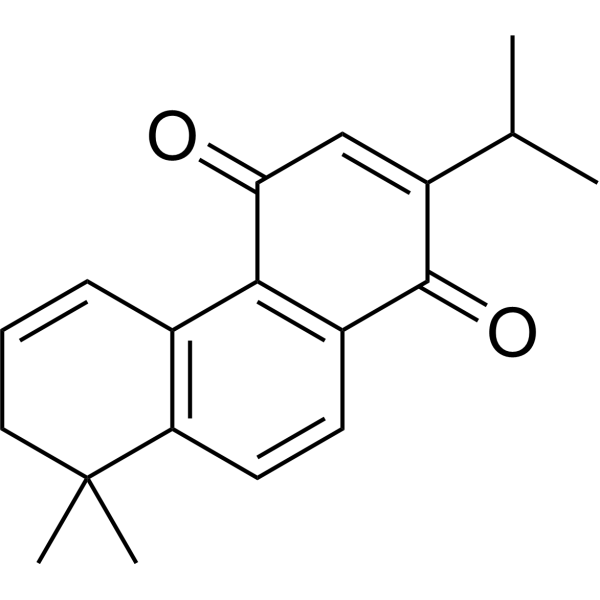Sibiriquinone ACAS# 723300-08-1 |

Quality Control & MSDS
Package In Stock
Number of papers citing our products

| Cas No. | 723300-08-1 | SDF | Download SDF |
| PubChem ID | N/A | Appearance | Powder |
| Formula | C19H20O2 | M.Wt | 280.36 |
| Type of Compound | N/A | Storage | Desiccate at -20°C |
| Synonyms | 7,8-Dihydro-8,8-dimethyl-2-(1-methylethyl)-1,4-phenanthrenedione | ||
| Solubility | Soluble in Chloroform,Dichloromethane,Ethyl Acetate,DMSO,Acetone,etc. | ||
| General tips | For obtaining a higher solubility , please warm the tube at 37 ℃ and shake it in the ultrasonic bath for a while.Stock solution can be stored below -20℃ for several months. We recommend that you prepare and use the solution on the same day. However, if the test schedule requires, the stock solutions can be prepared in advance, and the stock solution must be sealed and stored below -20℃. In general, the stock solution can be kept for several months. Before use, we recommend that you leave the vial at room temperature for at least an hour before opening it. |
||
| About Packaging | 1. The packaging of the product may be reversed during transportation, cause the high purity compounds to adhere to the neck or cap of the vial.Take the vail out of its packaging and shake gently until the compounds fall to the bottom of the vial. 2. For liquid products, please centrifuge at 500xg to gather the liquid to the bottom of the vial. 3. Try to avoid loss or contamination during the experiment. |
||
| Shipping Condition | Packaging according to customer requirements(5mg, 10mg, 20mg and more). Ship via FedEx, DHL, UPS, EMS or other couriers with RT, or blue ice upon request. | ||

Sibiriquinone A Dilution Calculator

Sibiriquinone A Molarity Calculator
| 1 mg | 5 mg | 10 mg | 20 mg | 25 mg | |
| 1 mM | 3.5668 mL | 17.8342 mL | 35.6684 mL | 71.3369 mL | 89.1711 mL |
| 5 mM | 0.7134 mL | 3.5668 mL | 7.1337 mL | 14.2674 mL | 17.8342 mL |
| 10 mM | 0.3567 mL | 1.7834 mL | 3.5668 mL | 7.1337 mL | 8.9171 mL |
| 50 mM | 0.0713 mL | 0.3567 mL | 0.7134 mL | 1.4267 mL | 1.7834 mL |
| 100 mM | 0.0357 mL | 0.1783 mL | 0.3567 mL | 0.7134 mL | 0.8917 mL |
| * Note: If you are in the process of experiment, it's necessary to make the dilution ratios of the samples. The dilution data above is only for reference. Normally, it's can get a better solubility within lower of Concentrations. | |||||

Calcutta University

University of Minnesota

University of Maryland School of Medicine

University of Illinois at Chicago

The Ohio State University

University of Zurich

Harvard University

Colorado State University

Auburn University

Yale University

Worcester Polytechnic Institute

Washington State University

Stanford University

University of Leipzig

Universidade da Beira Interior

The Institute of Cancer Research

Heidelberg University

University of Amsterdam

University of Auckland

TsingHua University

The University of Michigan

Miami University

DRURY University

Jilin University

Fudan University

Wuhan University

Sun Yat-sen University

Universite de Paris

Deemed University

Auckland University

The University of Tokyo

Korea University
- 2,4,6-Trimethoxyl-3-methylacetophenone
Catalog No.:BCX1884
CAS No.:39701-13-8
- Dehydrodanshenol A
Catalog No.:BCX1883
CAS No.:1444618-61-4
- Hymenoxin
Catalog No.:BCX1882
CAS No.:56003-01-1
- Pebrellin
Catalog No.:BCX1881
CAS No.:13509-93-8
- Chrysindin A
Catalog No.:BCX1880
CAS No.:1374852-85-3
- 3-Epidigitoxigenin
Catalog No.:BCX1879
CAS No.:545-52-8
- Marsdenoside B
Catalog No.:BCX1878
CAS No.:858360-57-3
- 11α-O-Tigloyl-12β-O-acetyltenacigenin B
Catalog No.:BCX1877
CAS No.:154022-51-2
- Ingol-7,8,12-triacetate-3-phenylacetate
Catalog No.:BCX1876
CAS No.:944799-46-6
- Euphorblin R
Catalog No.:BCX1875
CAS No.:2230806-06-9
- Strictinin
Catalog No.:BCX1874
CAS No.:517-46-4
- Tenuiphenone B
Catalog No.:BCX1873
CAS No.:870298-00-3
- 3-Epigitoxigenin
Catalog No.:BCX1886
CAS No.:465-10-1
- Lasiokaurinin
Catalog No.:BCX1887
CAS No.:52554-74-2
- Dichlorogelignate
Catalog No.:BCX1888
CAS No.:164030-91-5
- Digoxigenin
Catalog No.:BCX1889
CAS No.:1672-46-4
- 17α-Gitoxigenin
Catalog No.:BCX1890
CAS No.:4433-59-4
- Digitalin, 16-anhydro-
Catalog No.:BCX1891
CAS No.:7044-34-0
- Abrine D
Catalog No.:BCX1896
CAS No.:862504-05-0
- 4-((2-ethylidene-4-hydroxy-6-methylhept-5-en-1-yl)oxy)-bergaptol
Catalog No.:BCX1892
CAS No.:2519548-06-0
- 3,5,6,6-tetramethyl-4,5,5a,6,7,8-hexahydrocyclopenta[c]pentalen-2(1H)-one
Catalog No.:BCX1893
CAS No.:1689570-10-2
- Genistein 7-O-β-D-glucopyranoside-4’-O-[α-L-rhamnopyranosyl-(1→2)-β-D-glucopyranoside]
Catalog No.:BCX2014
CAS No.:361447-29-2
- 3-epi-Tilifodiolide
Catalog No.:BCX1897
CAS No.:1983982-42-8
- Licorisoflavan I
Catalog No.:BCX1894
CAS No.:2444736-45-0
Abietane diterpenes from Salvia miltiorrhiza inhibit the activation of hypoxia-inducible factor-1.[Pubmed:17583950]
J Nat Prod. 2007 Jul;70(7):1093-7.
The hypoxia-inducible factor-1 (HIF-1) has been known to be correlated to the adaptation and proliferation of tumor cells; therefore HIF-1 has become an important target in the development of anticancer drugs. A phytochemical study of the CHCl3-soluble fraction of Salvia miltiorrhiza, which strongly inhibited hypoxia-induced reporter gene expression, led to the isolation of 12 abietane-type diterpenes. Of these compounds, Sibiriquinone A (1), sibiriquinone B (2), cryptotanshinone (3), and dihydrotanshinone I (4) potently inhibited hypoxia-induced luciferase expression with IC50 values of 0.34, 3.36, 1.58, and 2.05 microM on AGS cells, a human gastric cancer cell line, and 0.28, 3.18, 1.36, and 2.29 microM on Hep3B cells, a human hepatocarcinoma cell line, respectively. Consistently, 1 and 4 dose-dependently suppressed the HIF-1alpha accumulation and 1 inhibited mRNA expression of vascular endothelial growth factor (VEGF) under hypoxia. These results suggest that the anticancer activity of tanshinones is likely at least in part associated with their inhibition of HIF-1 accumulation.
Immunosuppressive diterpenes from Veronicastrum sibiricum.[Pubmed:14709882]
Chem Pharm Bull (Tokyo). 2004 Jan;52(1):136-7.
Two new diterpenes, named Sibiriquinone A (1) and B (2), along with four known diterpenes have been isolated from the aerial part of Veronicastrum sibiricum. Their structures were elucidated by spectroscopy. The isolated compounds showed significant immunosuppressive activities.


